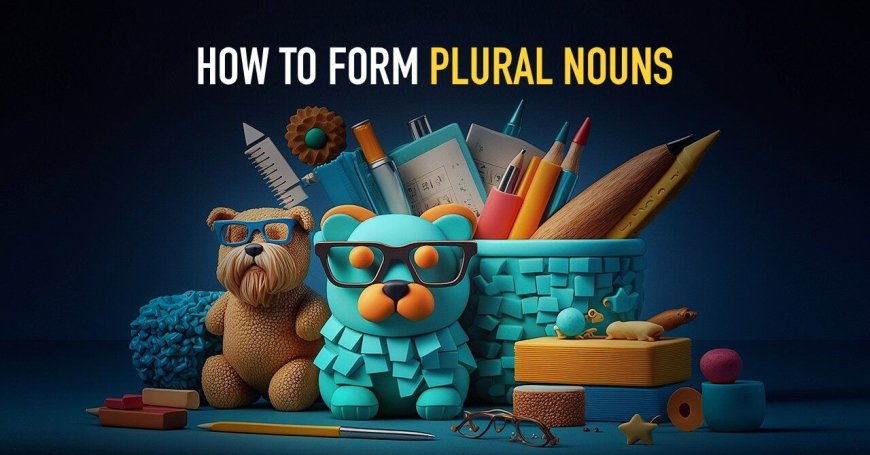Rules of Forming Singular Noun to Plural Nouns

Singular Noun and Plural Noun:
-
Singular Noun: A singular noun refers to a single person, place, thing, or idea. It represents only one item or individual. For example, "dog," "book," and "table" are singular nouns because they indicate a single dog, a single book, and a single table, respectively.
-
Plural Noun: A plural noun, on the other hand, refers to more than one person, place, thing, or idea. It represents a group or multiple items. Plural nouns are formed by adding an "-s" or "-es" to the end of the singular form in most cases. For example, "dogs," "books," and "tables" are plural nouns because they represent more than one dog, book, and table, respectively.
It's important to note that there are irregular plural forms in English that don't follow the standard "-s" or "-es" rule. Examples include "children" (plural of "child"), "mice" (plural of "mouse"), and "men" (plural of "man").
Rules of Forming Singular to Plural
Forming the plural of nouns in English generally follows certain rules. Here are some common rules for forming plural nouns:
-
Regular Plurals: Most nouns form their plurals by adding -s to the singular form. Example: car → cars, book → books, tree → trees
-
Plurals ending in -s, -ss, -sh, -ch, -x, or -z: When a noun ends in -s, -ss, -sh, -ch, -x, or -z, the plural is formed by adding -es. Example: bus → buses, glass → glasses, box → boxes
-
When it comes to forming the plural of nouns ending in "o," there are a few different rules that can apply. Here are the common possibilities:
-
Add -s: For most nouns ending in "o," simply add -s to form the plural. Example: photo → photos, piano → pianos, mango → mangos
-
Add -es: If the noun ending in "o" is preceded by a vowel (a, e, i, o, u), add -s to form the plural. Example: radio → radios, portfolio → portfolios, studio → studios
-
-
Plurals ending in -y: When a noun ends in a consonant followed by -y, the plural is formed by changing the -y to -ies. Example: baby → babies, city → cities, fly → flies
-
When a noun ends in a vowel followed by "y," the general rule for forming the plural is to simply add -s to the end of the word. Here are some examples:Play → plays, Boy → boys, Day → days, Key → keys, Valley → valleys
-
Plurals ending in -f or -fe: When a noun ends in -f or -fe, the plural is formed by changing the -f or -fe to -ves. Example: leaf → leaves, knife → knives, wolf → wolves
-
Irregular Plurals: Some nouns have irregular plural forms and do not follow the typical rules mentioned above. Example: child → children, mouse → mice, tooth → teeth
-
Plural Nouns that Stay the Same: Some nouns have the same form in both the singular and plural. Example: sheep, deer, fish, salmon, jewellery, information,oats, trousers, pliers and tweezers etc.
-
Compound Nouns: In compound nouns (nouns formed by combining two or more words), the plural is generally formed by adding -s or -es to the main word. Example: mother-in-law → mothers-in-law, passerby → passersby, bookshelf → bookshelves
- Exceptions: Some nouns undergo a vowel change, Example: man → men, goose → geese, foot → feet.
Plural forms of nouns of foreign origin
1. Noun ending in 'um'
Nouns of foreign origin can have varied plural forms in English. Here are some general guidelines for forming the plural of nouns borrowed from other languages:
-
Replace "um" with "a": For many Latin-derived nouns ending in "um," the plural form replaces "um" with "a." Example: curriculum → curricula, datum → data, medium → media
-
Replace "um" with "ums" or "a": Some nouns ending in "um" can take either "ums" or "a" in the plural form, and both are considered acceptable. Example: stadium → stadiums or stadia, maximum → maximums or maxima, museum → museums or musea
-
Keep "um" unchanged: Some nouns ending in "um" maintain the same form in both singular and plural. Example: forum (singular and plural), stratum (singular and plural), conundrum (singular and plural)
2. Noun ending in 'on'
-
Add -s: The simplest and most common way to form the plural of nouns ending in "on" is by adding -s to the end of the word. Example: button → buttons, cannon → cannons, icon → icons
-
Replace "on" with "a": Some nouns ending in "on" have their plural form by replacing "on" with "a." Example: phenomenon → phenomena, criterion → criteria, automaton → automata
3. Nouns ending in 'a'
Nouns ending in "a" can have various plural forms in English. Here are some common ways to form the plural of nouns ending in "a":
-
Add -s or e : The simplest and most common way to form the plural of nouns ending in "a" is by adding -s to the end of the word. Example: sofa → sofas, camera → cameras, umbrella → umbrellas, antennas → antennas/antennae, vertebra →vertebras/ vertebrae.
4. Nouns ending in 'us'
Nouns ending in "us" can have different plural forms in English. Here are some common ways to form the plural of nouns ending in "us":
-
Replace "us" with "i": Many nouns ending in "us" have their plural form by replacing "us" with "i." Example: focus → foci, nucleus → nuclei, radius → radii, fungus → fungi, syllabus → syllabi etc.
5. Nouns ending in 'is'
Nouns ending in "is" can have different plural forms in English. Here are some common ways to form the plural of nouns ending in "is":
-
Replace "is" with "es": One common way to form the plural is by replacing "is" with "es." Example: basis → bases, thesis → theses, crisis → crises, analysis → analyses, oasis → oases, hypothesis → hypotheses
6. Nouns ending in 'ex'
Nouns ending in "ex" can have different plural forms in English. Here are some common ways to form the plural of nouns ending in "ex":
-
Replace "ex" with "ices": One common way to form the plural is by replacing "ex" with "ices." Example: index → indices, appendix → appendices, vortex → vortices, vertex → vertices
7. Nouns ending in 'ix'
Nouns ending in "ix" can have different plural forms in English. Here are some common ways to form the plural of nouns ending in "ix":
-
Replace "ix" with "ices": One common way to form the plural is by replacing "ix" with "ices." Example: matrix → matrices, appendix → appendices, index → indices
-
Add -es: Some nouns ending in "ix" take the regular plural form by adding -es. Example: mix → mixes, fix → fixes, prefix → prefixes
Write the plural forms of these nouns:
- Stimulus
- Analysis
- Cactus
- Stratum
- Phenomenon
- Father -in- law
- Criterion
- Larva
- Vertebra
- Index
What's Your Reaction?






















































